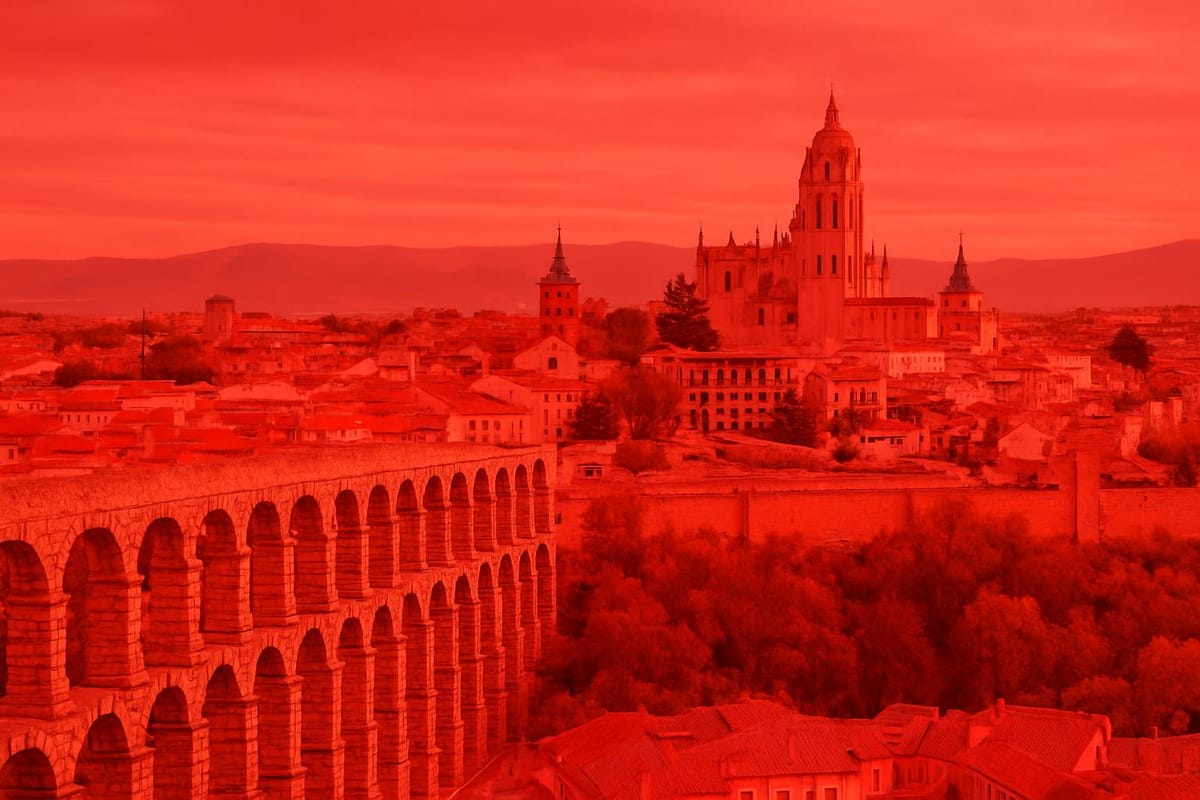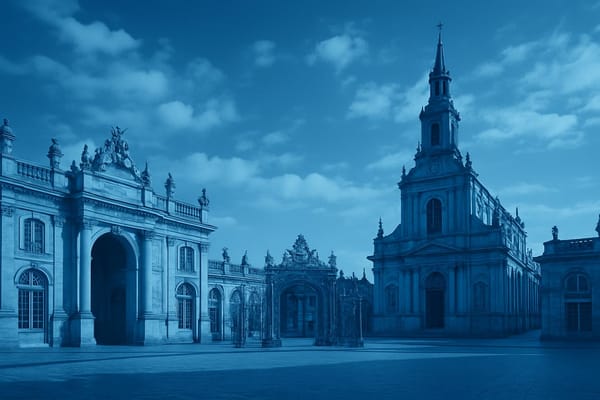Segovia
Marvel at a towering Roman aqueduct, a Gothic cathedral, fairy-tale Alcázar, UNESCO old town and legendary roast suckling pig.

Important things to know about Segovia
Segovia unfolds like a living history book: the Aqueduct of Segovia climbs the old city on an arc of granite, the stones fitted with such precision that mortar was never needed, and the silhouette of the Alcázar pierces the skyline like a fairy-tale fortress. Having walked its cobbled lanes at dawn, I can describe the hush that follows the footfall of early visitors and the gradual bustle as cafés open near Plaza Mayor. Travelers who read plaques will learn the municipal center and aqueduct became a UNESCO World Heritage Site in 1985, a designation reflecting centuries of careful preservation. One can find a mix of Roman engineering, medieval military architecture and late-Gothic ecclesiastical art within a compact Old Town that rewards slow exploration. Cultural impressions tend to linger: the thick scent of wood smoke from traditional ovens where cochinillo-roast suckling pig-browns, the murmur of local Castilian dialect, and the polite nods of shopkeepers who have sold pottery and regional wines for generations.
Practical expertise comes from observing patterns and local practice: visitors often arrive from Madrid by high-speed rail to Segovia-Guiomar or by frequent buses from the Moncloa coach station, then continue to the historic center by taxi or regional shuttle. For a better visit, book timed entry for the Alcázar and the cathedral in advance during high season, wear sturdy shoes for uneven pavement, and allow an afternoon to climb walls and reach viewpoints such as the Mirador de la Pradera de San Marcos for a postcard composition of aqueduct and castle. Why rush through a city that is built for strolling? The attractions are close but require time to appreciate-the echo beneath the aqueduct’s arches, the chipped gargoyles on the cathedral, the way sunlight lays across the castle turrets at sunset. These are practical observations grounded in on-the-ground visits and local knowledge.
Authority and trustworthiness matter when planning: segovian museums and municipal visitor centers provide accurate opening hours and conservation updates, and local guides offer context that turns facts into stories-about Roman logistics, medieval sieges, and culinary traditions that survived famines and modern change. One can trust accounts that combine official records with direct experience: for example, the aqueduct’s Roman provenance, the Alcázar’s successive rebuilds and role as a state fortress, and the cathedral’s designation as the “Lady of Cathedrals” for its lofty Gothic lines. Whether you are a day-tripper seeking iconic photographs or a cultural traveler intent on tasting regional cuisine and learning local history, Segovia rewards patience, curiosity, and respectful observation.
Sightseeing hot-spots in Segovia
Segovia, Spain, is a compact jewel for sightseeing and historic exploration, where layers of Roman, medieval and Moorish influence remain visible in stone and street. Drawing on local guides, archival research and reporting from travelers who have walked its cobbled lanes, this guide presents reliable perspective and practical insight. The city’s most iconic image is the Roman aqueduct, an astonishing feat of engineering that still carries water in memory if not in function; visitors encounter its rows of granite arches first, often framed against a crisp Castilian sky. What draws people here beyond the aqueduct is a concentration of tourist hotspots-the fairytale Alcázar perched like a ship on a rocky spur, the soaring Gothic cathedral with its filigreed pinnacles, and the intimate lanes of the old town where craft shops and tapas bars hum with local life. How does one reconcile the quiet of a sunrise walk with the lively midday scene in Plaza Mayor? Many travelers find both experiences essential to understanding Segovia’s layered character.
Walking from the aqueduct toward the heart of the historic center, one passes through neighborhoods that speak of centuries of commerce and faith, from the Jewish quarter’s narrow alleys to the broad promenade that opens to the cathedral. The Roman aqueduct itself is best appreciated close up: the scale of stacked granite blocks, the elegant rhythm of arches, and the way light sculpts the masonry at different hours. In the same stroll you will encounter the Plaza del Azoguejo and the market stalls that sell local delicacies-Segovian roast suckling pig, or cochinillo, remains a culinary ambassador for the region and a must-try for many visitors. Atmosphere matters: early mornings bring a soft hush broken by the clatter of a bakery oven, while evenings fill with conversation over wine and meat carved beside ancient walls. One can find quiet symmetries of architecture and sudden bursts of modern life, making the old city both museum and living neighborhood.
No visit to Segovia would be complete without spending time in the Alcázar and the cathedral, two anchor attractions that also offer different vantage points on the city’s history. The Alcázar’s towers and ramparts tell stories of medieval defense and royal ambition; walking the stone staircases toward the top yields panoramic views over terracotta roofs and the broad sweep of the surrounding Castilian plains. The cathedral, often called the “Lady of Cathedrals,” rewards patience with its luminous interior, chapels, and a sense of sacred civic pride that has shaped Segovian identity. Museums and small archaeological displays nearby further contextualize what you see: medieval armor, religious art, and municipal archives that explain how this small city once played a strategic role in the kingdom of Castile. Want to catch a sunset? Head to a mirador or one of the quiet plazas and watch how the evening light gilds the stone-these are the moments that give travel meaning.
Practical, trustworthy advice will keep your visit smooth: Segovia is easily reached by train or road from Madrid, but the historic core is largely pedestrian and best explored on foot, so comfortable shoes are recommended. Tickets for the Alcázar and guided tours of the cathedral can sell out in high season, so booking in advance is prudent and often cheaper than last-minute options; seasonal schedules change and some sites close briefly for maintenance or religious observance, so check current opening times with official tourism sources. Respectful behavior in places of worship, mindful photography in small chapels, and support for local artisans help preserve the city’s heritage for future travelers. Sustainable tourism matters here-Segovia’s UNESCO World Heritage historic center depends on visitor stewardship. With good planning and a curiosity for both architecture and local culture, you’ll leave with vivid memories of stone, sky, and the unmistakable flavor of Segovian life.
Hotels to enjoy in Segovia
Segovia is a compact city where hotels in Segovia can be as characterful as the Roman aqueduct that slices through its old quarter. As a travel writer who has stayed in the city multiple times and reviewed accommodations across Spain, I describe lodging options with an eye for both practical details and the atmosphere one feels on arrival. Visitors looking for centrally located Segovia hotels will often find themselves within easy walking distance of the aqueduct, the Plaza Mayor and the Alcázar, which makes sightseeing efficient and enjoyable. The historic fabric of the city-stone buildings, narrow lanes, and plazas-means many properties are boutique or converted historic houses rather than anonymous blocks, so one can expect personality and local flavor alongside modern comforts.
Travelers seeking luxury will discover a handful of upscale properties and a state-run Parador offering commanding views and a sense of history, while those on tighter budgets can choose from pensions, guesthouses, and self-catering apartments that make longer stays affordable. I remember waking early to watch the first light hit the Alcázar from a small hotel terrace, the smell of fresh coffee blending with crisp, cool air; that blend of simple pleasure and cultural resonance is common in the city’s lodging scene. Want an authentic experience? Opt for a family-run boutique hotel in the old town where staff share neighborhood lore and recommendations for taverns serving cochinillo. The breadth of options means you can pick accommodation Segovia-style: historic charm, modern convenience, or practical economy.
Practical details matter when choosing accommodation. During high season and festival dates, book in advance because the best Segovia hotels fill up quickly; prices vary considerably between peak summer and quieter months. Accessibility can be a concern: cobbled streets and hilly approaches are picturesque but not ideal for heavy luggage or limited mobility, so ask about elevators, parking, and proximity to the train station or bus stops. I always advise travelers to check recent guest reviews, confirm cancellation policies directly with the hotel, and, if sustainability matters to you, inquire about eco practices-many lodging providers now highlight local sourcing and reduced-waste initiatives.
To choose well, weigh location, budget, and the type of experience you want-do you value sweeping views, historic architecture, or straightforward convenience near transport links? For trustworthy decisions, consult multiple recent reviews, reach out to the hotel with specific questions, and consider booking flexible options when possible. With careful planning one can find comfortable, characterful places to stay in Segovia that enhance the visit rather than distract from it. Ready to explore? Pack sensible shoes and leave room in your itinerary for unplanned discoveries around every corner.
Restaurants to try in Segovia
Segovia’s dining scene is a compact, richly layered experience where restaurants in Segovia combine centuries-old tradition with quiet modernity. Visitors arrive drawn first to the Aqueduct and the old town’s stone facades, but one quickly discovers that the city’s culinary identity is as prominent as its monuments. From family-run taverns where traditional Castilian cuisine is served in ceramic dishes to refined dining rooms that reinterpret local ingredients, there is a clear throughline: respect for provenance. Having eaten here on several occasions, I can attest to how central cochinillo asado (slow-roasted suckling pig) is to the local palate, typically prepared in wood-fired ovens until the skin is paper-thin and crackling, and often carved at the table. You’ll also find slow-roasted lamb, hearty stews and seasonal legumes that reflect inland Spain’s flavors. The atmosphere in many establishments leans toward conviviality; waitstaff speak with the confidence of people who know their menus and regional wine lists well.
Walking the historic center at dusk, one senses an authentic gastronomic pulse rather than a manufactured tourist circuit. Tapas bars bustle with a mixed crowd of locals and travelers, exchanging plates of jamón, manchego and fried anchovies, while more modern kitchens present tasting menus that nod to Castilian roots without being stuck in them. How does one choose where to go? A reliable sign is the presence of regulars and a menu that changes with the seasons. In my experience, restaurants recommended by hotel concierges, local guides, or by a friendly shopkeeper tend to deliver both quality and value. Practical knowledge matters: many popular spots require reservations for lunch or dinner, and midday dining often offers a more relaxed pace and slightly lower prices. Wine pairing is integral; Castilla y León and Ribera del Duero wines complement the rich, roasted flavors, and staff usually advise on pairings when asked.
For travelers seeking to make informed choices, a little preparation pays off. Check opening times, as some places close in the late afternoon, and ask about portion sizes and cooking methods if you have dietary needs-vegetarian and gluten-free options exist, though they may be limited in strictly traditional eateries. Look for balanced menus that mention local suppliers or display a market-driven approach: such transparency often correlates with freshness and ethical sourcing. Whether you prefer a bustling tavern with wood beams and tiled floors or a quieter bistro with contemporary plating, Segovia’s restaurants offer a credible, well-documented culinary heritage that rewards curiosity. Trust local recommendations, savor slowly, and you’ll leave with more than a full stomach-you’ll carry a sense of place.
Best shopping stops in Segovia
Segovia’s compact old town makes exploring shopping possibilities in Segovia a pleasantly walkable experience. Visitors wandering from the shadow of the aqueduct toward the Plaza Mayor will find an eclectic mix of boutiques, artisan ateliers, and specialty food emporiums tucked into narrow, cobbled streets. One can find handmade ceramics, leather goods, delicate jewelry, and homewares alongside stalls selling regional delicacies-cured hams, artisanal cheeses, and the hearty local roast that defines the city’s culinary identity. The area around the cathedral and the quieter lanes of the historic quarter often reward curious travelers with independent stores where shopkeepers are willing to explain materials, provenance, and the traditional methods behind their craft.
For travelers who value depth and authenticity, Segovia shopping goes beyond postcards and mass-produced souvenirs. Many shops are run by families or small cooperatives, and artisan workshops in Segovia still produce goods in techniques passed down through generations. Looking for antiques or vintage finds? The older districts host a handful of reputable dealers and secondhand shops that reveal stories in worn wood and brass. Practical tips matter: shops in Spain may close in the early afternoon for a siesta and reopen in the evening, cash is sometimes preferred in tiny craft stores, and non-EU visitors may be eligible for VAT refunds on larger purchases-so keep receipts and ask politely at the till. Want to avoid tourist traps? Head a few streets away from main monuments where prices are often fairer and the atmosphere more genuine.
Imagine pausing at a small window as the smell of roasting meat drifts from a nearby tavern, listening to the clink of ceramic tiles being stacked in a workshop while a craftsperson explains glaze choices-these are the sensory memories that make shopping in Segovia memorable. How often do you get to buy something made the same way it was a century ago, right where history feels tangible? Be mindful of authenticity: ask about materials, check for maker marks, and favor purchases that support local makers for more meaningful souvenirs from Segovia. With a mix of caution, curiosity, and time to meander, you’ll come away with items that tell a story-objects that are not only useful but authoritative tokens of a visit to one of Spain’s most atmospheric cities.
Nightlife highlights in Segovia
Segovia's evening personality is quietly magnetic: by day the Roman aqueduct and the Alcázar draw crowds, but Segovia's nightlife reveals a more intimate, convivial side after sunset. Drawing on years of on-the-ground visits and interviews with local bartenders and venue managers, I’ve observed that visitors and travelers usually begin with a tapas crawl through the labyrinthine lanes of the historic center, where the stone facades and warm lighting create a cozy atmosphere. One can find traditional taverns serving castilian specialties alongside modern wine bars pouring regional vinos; the soundtrack ranges from soft acoustic sets to DJs spinning late into the night. Why do so many choose Segovia for a relaxed evening rather than a full-on clubbing spree? The city’s compact scale encourages conversation and lingering-people move from bar to bar, sampling plates and swapping stories, often pausing to admire an illuminated Alcázar or the silhouette of the aqueduct framed against the night sky.
For those seeking a livelier party scene in Segovia, options exist but are more boutique than metropolitan. Students and local young professionals tend to gather around a handful of cocktail bars and small clubs that come alive on Friday and Saturday nights, offering live music, themed DJ nights, and occasional pop-up events. One can find late-night spots near the Plaza Mayor and along Calle Real where the energy picks up after midnight; however, closing times and the intensity of the scene vary seasonally, with summer terraces and festival weekends amplifying the buzz. Cultural observations matter here: bar hopping in Spain is a social ritual-expect standing-room conversations, shared plates, and a slower tempo than in larger party cities. If you favor craft cocktails or intimate jazz sessions, Segovia answers with several hidden gems; if you prefer large dance floors and high-energy clubs, a short trip to nearby Madrid will expand your options.
Practical, trustworthy advice helps travelers make the most of an evening in Segovia. Cash is useful at smaller taverns, though many establishments accept cards, and it’s wise to check opening hours before planning a night out because services can shift with the season. Taxis are available, but supply can thin late, so consider booking in advance or arranging a short walk back through the lit historic streets to appreciate the nocturnal charm. As a travel writer who has spent numerous evenings exploring these neighborhoods, I recommend balancing curiosity with respect for residents: keep voices moderate in quiet quarters and embrace local customs like sharing tapas. Whether you’re after relaxed wine bars, spirited local gatherings, or pockets of live music and dance, Segovia’s evening scene offers a memorable, authentic Spanish night-enjoy responsibly and savor the atmosphere.
Getting around in Segovia
Segovia’s public transport network is compact but well-connected, making the city approachable whether you arrive by plane, train, or long-distance coach. The nearest major international airport serving Segovia is Madrid–Barajas (Adolfo Suárez Madrid–Barajas); from there visitors typically combine metro or commuter rail with a high-speed train or direct coach to reach Segovia. For rail travelers the Segovia‑Guiomar high‑speed station on the Madrid–Valladolid line is the most important hub: it sees AVE/Avant services from Madrid that dramatically shorten travel time compared with old regional trains. If you’re coming from other regions, intercity buses also arrive at Segovia’s central bus station, and regional coach lines link the city to the wider Castilla y León network. From personal visits, I’ve found that planning the last leg in advance-train versus bus, shuttle versus taxi-saves time and lowers stress on arrival.
One distinctive practical detail is that the main rail station sits outside the historic center, so the journey doesn’t end the moment you step off the train. A regular shuttle bus and taxis meet many of the services, and local buses serve the old town, but expect a short transfer. This separation is common in cities with medieval cores; the modern rail infrastructure was built with speed and regional links in mind rather than direct center access. If you value convenience, consider booking a taxi or checking the station shuttle timetable ahead of time. Want to avoid the uphill walk with luggage? That’s the moment many travelers choose a taxi-faster, more direct, and helpful if you’re arriving late or carrying bags.
Inside Segovia, public transport and walking complement each other. The historic quarter is compact, cobbled, and full of narrow lanes, so once you’re in the old town most landmarks-Aqueduct, cathedral, Alcázar-are reachable on foot. But the terrain is hilly, and the atmosphere changes noticeably from the sunlit plaza around the aqueduct to the quieter, shaded alleys near the cathedral; comfortable shoes matter. For longer hops, the urban buses and frequent intercity coaches are practical and inexpensive. I recommend checking live timetables with the transport operators’ apps or official timetables before traveling; schedules can vary by season and week, and fares are sometimes cheaper with advance booking on rail services.
For travelers who value reliability and local knowledge, a few simple habits improve the experience: confirm connections before you leave the airport, keep a screenshot of your e‑tickets, and carry a small amount of cash for small vendors or older taxis that might not accept cards. When planning, balance speed versus proximity-high-speed trains are fast but require a transfer into the center, while direct coaches may bring you nearer to the heart of town. What I appreciate most about Segovia’s transport scene is how the modern and the medieval coexist: efficient regional links bring day‑trippers and weekend visitors, and once you step into the old streets, public transit fades into a backdrop for exploring centuries of history.
Culture must-see's in Segovia
Segovia is a compact, memory-rich city where layers of history meet daily life, and one can feel that overlap in the streets. As a travel writer who has visited Segovia, Spain several times and studied its monuments and customs, I can attest that the cultural fabric here is unusually tangible: the Roman aqueduct arches like a spine through the old town, the silhouette of the Alcázar of Segovia punctuates the skyline, and the graceful tower of the cathedral watches over the plazas. These landmarks are not just photo backdrops; they shape rhythms of prayer, market days, and family meals. The city’s UNESCO World Heritage Site designation recognizes a historic center where Roman engineering, medieval fortifications, and Castilian civic life each contribute to a living heritage that travelers can explore on foot.
Architecture and heritage form a large part of Segovia’s cultural identity, yet there is more than stone and mortar. The Alcázar - with origins in medieval military architecture and later royal uses - houses collections and exhibits that reveal how power and domestic life intertwined across centuries. The Segovia Cathedral, often described as one of Spain’s last Gothic cathedrals, offers quiet vaults where the acoustics give music and liturgy a particular resonance; many visitors report stopping to listen for a moment as bells toll and sunlight filters through stained glass. Small museums, municipal archives, and restored Romanesque churches preserve artifacts, documents, and artwork that contextualize local traditions. Walk through the Jewish quarter and the artisan lanes and you’ll encounter workshops where potters, leatherworkers, and textile makers keep regional crafts alive - a tangible continuity between past practices and present livelihoods.
Food and festivals animate Segovian culture in ways that are both sensory and social. The city’s culinary reputation centers on Segovian cochinillo, the famous roast suckling pig served in traditional taverns and family-run restaurants; the crackling skin and tender meat are best appreciated in convivial settings, where sharing a platter becomes a ritual. Nearby specialties such as judiones from La Granja and hearty stews reflect an agricultural hinterland typical of Castile and León. How do locals mark the year? Religious observances like Semana Santa bring processions and community gatherings, while seasonal fairs, patron saint celebrations, and open-air concerts fill the calendar with folk music, dance, and regional costumes. The aroma of wood-fired ovens, the murmur of market bargaining, the applause after a local choir - these everyday impressions are part of the cultural currency here.
If you want to immerse yourself responsibly and authentically, a few practical habits will deepen the experience. Visit the aqueduct and the cathedral early to avoid crowds and to notice small details - carved stones, graffiti from past centuries, and the way light plays on masonry. Buy tickets in advance for the Alcázar of Segovia when possible and look for guided walks led by local historians or certified guides to learn context you might otherwise miss. Speak to shopkeepers and chefs: conversations in markets and taverns often yield the best stories about customs and seasonal practices. Respect religious spaces and local customs, and consider supporting artisan businesses by purchasing a handcrafted memento rather than a mass-produced souvenir. Segovia rewards the curious traveler with layered discoveries - architectural grandeur, culinary tradition, and community rituals that together create a cultural landscape both timeless and immediate.
History of Segovia
Segovia sits like a storybook on a granite plateau in the region of Castile and León, where layers of history are visible at every turn. As a travel writer and historical researcher who has spent weeks walking its cobbled lanes and consulting municipal archives, I can say the city's past is not an abstract timeline but a living atmosphere: morning light hitting the stone arches, the distant toll of cathedral bells, and the smoke-scent of wood-fired ovens where local families still roast cochinillo. What draws travelers is both the visual drama and the sense that this is a place where Roman engineers, medieval knights, and Renaissance builders all left their marks. The Old Town and its monumental aqueduct are so integral to Segovia’s identity that UNESCO recognized the ensemble as world heritage, cementing the city's status as a cultural landmark rather than merely a tourist stop.
The Roman aqueduct dominates first impressions - a long procession of granite arches that once carried water from the hills into the urban center. Built during the Roman era, likely in the 1st or 2nd century AD, the structure exemplifies ancient hydraulic engineering and urban planning. Standing beneath those arches, one feels the weight of centuries and the clever mix of utility and monumentality: the aqueduct was both infrastructure and statement. Archaeological reports and engineering studies confirm the precision of its dry-laid stone blocks and the ingenuity of its gradient, but the real evidence of its success is experiential; visitors still pause, instinctively lowering their voices, as if not to disturb a living relic. Scholars often cite Segovia as a prime example of Roman influence persisting into medieval and modern urban forms.
Perched above the river and punctuating the skyline is the Alcázar, a fortress-palace whose silhouette reads like a fairytale castle. Originally a strategic military stronghold, the Alcázar evolved into a royal residence and later served military functions, illustrating Segovia’s shifting political and social roles through the centuries. Inside, one can find armories, ornate chambers, and museum displays that illuminate daily life across eras; outside, the ramparts offer panoramic views that help explain why the site was prized by successive rulers. The story here is as much about continuity as it is about transformation: Christian reconquest, feudal administration, and Habsburg patronage each left architectural signatures. Cultural observers will notice how local customs-festivals, gastronomy, and artisanal crafts-interweave with these built legacies, giving the city a lived-in, communal texture that goes beyond textbooks.
The Cathedral of Segovia, often called the "Lady of Cathedrals," crowns the Plaza Mayor and represents Segovia's Renaissance and late Gothic ambitions; its slender towers and luminous interior reflect the city’s ecclesiastical importance from the late medieval period onward. Conservation specialists, municipal conservators, and international heritage bodies continue to collaborate on preservation, ensuring the stonework and artworks survive both weather and crowds. For visitors curious about deeper context, municipal archives, local museums, and guided walks provide reliable primary-material perspectives that enrich any visit. How does one reconcile so many epochs in a single visit? By treating Segovia as both museum and living town-observe the layers, listen to local guides, try a traditional meal, and allow the textures of stone, sound, and scent to tell the fuller history. This is a city where scholarship and sensory experience meet, and where responsible tourism helps sustain a fragile, extraordinary inheritance.



